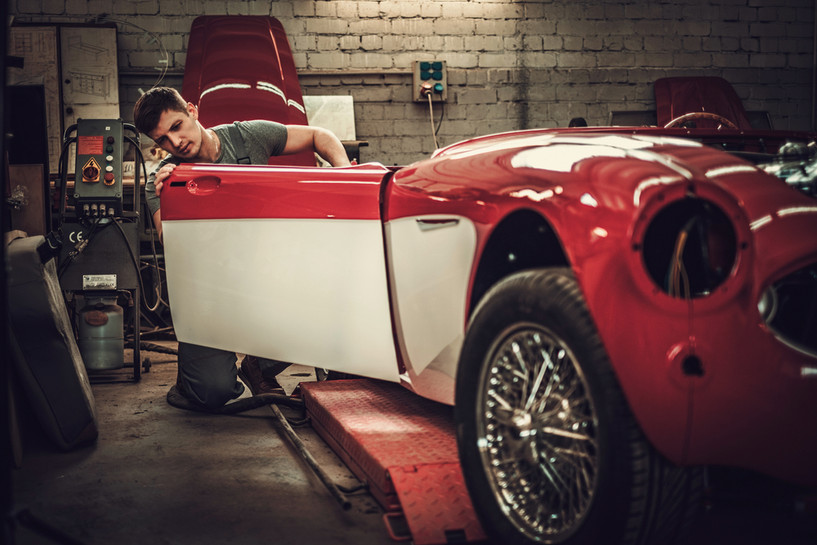While some people own and maintain one or more classic cars purely for individual purposes, many are also interested in this area because of the community around it. Classic cars are a huge area of interest for many people, with everything from car shows to antique sales taking place regularly - and within this realm, one important area to be aware of is the differing tiers of classic car restoration that can be achieved.
At Andersen Restoration Parts, we offer an extensive range of classic car restoration parts, including everything from strut rod kits and polyurethane kits to suspension kits, center links and more. We'll help you achieve any level of car restoration you're looking for, including any of the four tiers that are generally used within this world. What are these tiers, what's generally required to achieve each of them, and what else do you need to know here? Let's take a look.
Use of a 100-Point System
Typically, those in the classic car restoration world use a 100-point system to rate the quality of a given car's restoration. This scale goes from 1 on up - any number under 20 is considered simply un-restorable, while 100 itself would signal perfect restoration. There are a variety of ranges here, which we'll discuss in our subsequent section.
Restored to Driving Condition
Also simply known as "driving quality," the first level of classic car restoration is focused on providing a car that can be driven safely on the road without creating any safety or legality issues. The car simply needs to be able to get from point A to point B without any problems, but it doesn't need to look great.
What it takes to achieve this level of restoration will depend heavily on the state of the car when you start. It may require some simple repairs and adjustments, or it could be more involved if the car requires extensive body repair work. Generally speaking though, at this tier of classic car restoration your goal is to simply make the car driveable and safe for everyday use.
On the 1-100 scale, this level of classic car restoration typically falls in the range of about 21-80 points - easily the widest range. Some cars can technically be "driveable" while still being relatively low-quality; those would be in the lower ranges, while cars with a few more of the bells and whistles might be closer to 80.
Restored to Street Show Condition
Also called "street show quality," this level of classic car restoration is focused on making the car look great and be safe enough to drive - and to look at least respectable, if not better. From a running standpoint, this tier will involve higher-quality parts and likely some professional repairs, which will bring the car to a higher standard.
Body-wise, this tier of classic car restoration is focused on making sure that all parts are in their proper positions and look as close to factory condition as possible. Paint jobs are definitely necessary here, and many people also opt for chrome work and other various modifications at this level too - though such modifications aren't strictly required.
On the 1-100 scale, street show quality typically falls into the 80-90 range. This signals that the car looks great and is in good condition, but it's still not quite perfect.
Restored to Show Car Condition
For those who plan to take their car to one or more car shows, this third tier of restoration is necessary. As the name implies, show car condition requires the car to be in its absolute best condition, with all parts and pieces perfectly working together and looking incredibly pristine.
At this level of classic car restoration, all body work must be complete, paint jobs should have a near-perfect finish, and all chrome should be covered. Professional work and attention to detail are virtual prerequisites here, as cars in this condition must almost always meet very high standards.
On the 1-100 scale, show car condition usually lies between 90 and 95 points - signaling that essentially everything needs to be perfect here, from body work to paint jobs and beyond.
Restored to Concours Condition
Finally, the very highest level of classic car restoration is this one, which is reserved for certain specialty auto shows, private collectors or vehicles that have never been driven once. These vehicles will need a rating of at least 95 points on the 1-100 scale to qualify, and they must also meet extremely high standards of excellence.
For these cars, no stone is left unturned - literally. Everything from the paint job to the chrome work to any engine repairs must be done perfectly and in pristine condition. The car should look factory fresh, and even small blemishes or imperfections will be heavily scrutinized.
Cars in this condition can also qualify for certain awards, such as the Concours d'Elegance, where collectors from all over the world come together to share their prized vehicles. It's a great way to showcase your vehicle and give it the attention it deserves after all of its work.
For more on the varying tiers of classic car restoration, or to learn about any of our classic car restoration parts or services, speak to our team at Andersen Restoration Parts today.

